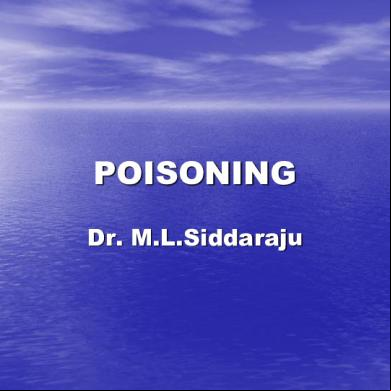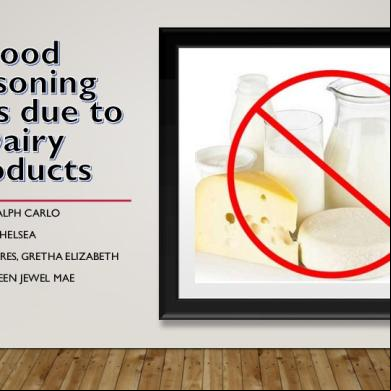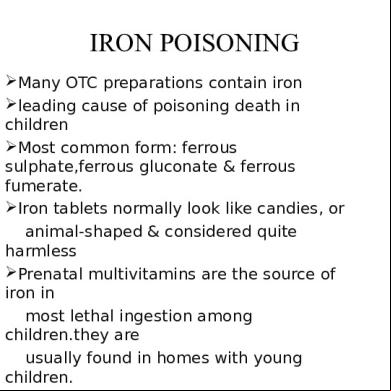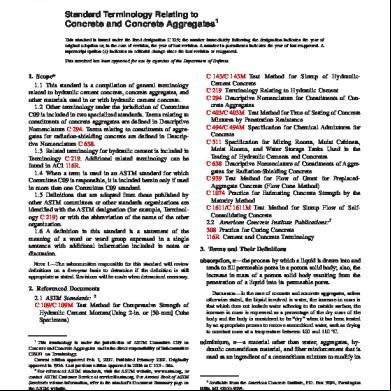Oleander Poisoning 2i4o72
This document was ed by and they confirmed that they have the permission to share it. If you are author or own the copyright of this book, please report to us by using this report form. Report 2z6p3t
Overview 5o1f4z
& View Oleander Poisoning as PDF for free.
More details 6z3438
- Words: 833
- Pages: 26
Oleander Poisoning
Dr. Shatdal Chaudhary MD Assistant Professor Department of Internal Medicine, BPKIHS, Dharan
case
• 32 yr female came to ER on 14/2/2066 – Multiple episodes of vomiting – H/o ingestion of 4 oleander seed after family dispute
• itted in CCU • Developed sinus bradycardia and first degree heart block • Treated with atropine infusion and discharged on day 7
Oleander • Also known as Kaner • Wide spread in Nepal and India. • Flowers are used as offerings in the temples
• Can be used for – Suicide – Accidental poisoning especially in children – Abortion – Cattle poison
• In Sri Lanka– In some areas up to 40% of suicidal poisoning cases are now linked to oleander seeds. – annual incidence of >150 per 100 000. – mortality rate of about 10%. – results in about 2000 deaths each year.
• Accidental oleander poisoning occurs throughout the tropics and subtropics • oleander caused 27%of the paediatric plant poisonings in Australia
• There are two varieties – Nerium oleander- Common, pink or white Oleander – Thevetia peruviana- Yellow Oleander All the parts are poisonous
White Oleander (Nerium oleander) • The active principle is nerin • It consisting of three glycosides – Neriodorin: Acts on heart similar to digitalis – Neriodorein: cause muscular twitching and tetanic spasms – Karabin: Affect heart as well as cause muscular spasms. Toxic effects last for 3-6 days.
Cl ini cal Featu res Local, Gastrointestinal, Cardiac, Neurological • Vomiting, Pain abdomen, salivation and restlessness. • Difficulty in swallowing and lock jaw • Muscular twitching, tetanic spasm • Pulse- slow various Brady arrhythmias, SVT with various degree of AV block. • Heart failure, coma Fatal Dose: • about 15 grams of roots, 5-15 leaves – can kill an adults in about 24 hrs
Yellow Oleander (Cerbera Thevetia) • Contains at least eight different cardiac glycosides, including Thevetin A, Thevetin B, thevetoxin, neriifolin, peruvoside and ruvoside. – Thevetin B- Acts like strychnine – Thevetin A- acts like digitalis – Thevotoxin• acts like digitalis • Less toxic than thevetin • Presents in kernels of the seeds
Cl ini cal Featu res • seeds are usually eaten as whole or in chunks . • Large variation in the amount of absorption of cardio active toxins from a seed • the number of seeds ingested does not always correlate with the degree of toxicity • Burning sensation in the mouth, dryness of the throat, vomiting, diarrhoea • Fragments of seeds can be seen in the stomach contents
• Dizziness, tetanic convulsions • Various Brady arrhythemia are can be seen ranging sinus bradycardia to various degree heart block. • sudden cardiac death can occur due to ventricular fibrillation or cardiac asystole
Fatal dose: 8-10 seeds 15-20 grams of roots 5-15 leaves
Treatment • Continuous ECG monitoring for at least 24 h is necessary to detect arrhythmias • longer monitoring in patients with severe poisoning. • Correct dehydration with iv fluids • Correct electrolyte imbalance – Hypokalemia / hyperkalemia both must be corrected.
• Hyperkalemia is best treated with insulin-dextrose infusion. • Antiemetics to control severe vomiting. • Gastric decontamination by the use of single dose and multiple doses of activated charcoal
Activated Charcoal Rationale • activated charcoal prevent the initial absorption of the toxic glycosides, but also prevent toxin reabsorption • After absorption into the systemic circulation, cardiac glycosides are secreted into the gut lumen from the systemic circulation. • In the gut, activated charcoal binds the secreted glycoside and encourages further secretion, and helps in glycoside excretion.
Activated Charcoal 50 g of activated charcoal every 6 h for 3 days or sterile water as placebo. 201 patients received multiple-dose activated charcoal and 200 placebo. There were fewer deaths in the treatment group (five [2·5%] vs 16 [8%]; percentage difference 5·5%; 95% CI 0·6–10·3; p=0·025), Multiple-dose activated charcoal is effective in reducing deaths and life-threatening cardiac arrhythmias after yellow oleander poisoning and should be considered in all patients. Treatment of patients who had yellow oleander poisoning with multiple doses of activated charcoal over 72 h reduced the death rate by 69%. M Eddleston et al. Lancet 2003; 361: 1935–38
Atropine • IV Atropine three 2 mg intravenous boluses at 5–10 min intervals, or infusions of 12 mg/h for: a) sinus bradycardia <50 per min b) sinus bradycardia <60 per min and low systolic blood pressure c) All other bradyarrhythmias
Bradyarrhythmias. • Adrenaline, Noradrenaline, isoprenaline • Tachyarrhythmias- iv lignocaine • Temporary cardiac pacing
Digoxin-specific Fab antibody Fragments • 66 patients who presented to hospital with a serious cardiac arrhythmia were randomised to receive either 1200 mg of anti-digoxin Fab or placebo. • 34 patients received anti-digoxin Fab and 32 • received placebo. • The presenting arrhythmia had resolved completely after 2 h in 15 antibody-treated patients and two controls (p<0·001); 24 patients and five controls, respectively, were in sinus rhythm at 8 h (p<0·001). M Eddleston and D A Warrell et al. Lancet 2000; 355: 967–72
The End
Dr. Shatdal Chaudhary MD Assistant Professor Department of Internal Medicine, BPKIHS, Dharan
case
• 32 yr female came to ER on 14/2/2066 – Multiple episodes of vomiting – H/o ingestion of 4 oleander seed after family dispute
• itted in CCU • Developed sinus bradycardia and first degree heart block • Treated with atropine infusion and discharged on day 7
Oleander • Also known as Kaner • Wide spread in Nepal and India. • Flowers are used as offerings in the temples
• Can be used for – Suicide – Accidental poisoning especially in children – Abortion – Cattle poison
• In Sri Lanka– In some areas up to 40% of suicidal poisoning cases are now linked to oleander seeds. – annual incidence of >150 per 100 000. – mortality rate of about 10%. – results in about 2000 deaths each year.
• Accidental oleander poisoning occurs throughout the tropics and subtropics • oleander caused 27%of the paediatric plant poisonings in Australia
• There are two varieties – Nerium oleander- Common, pink or white Oleander – Thevetia peruviana- Yellow Oleander All the parts are poisonous
White Oleander (Nerium oleander) • The active principle is nerin • It consisting of three glycosides – Neriodorin: Acts on heart similar to digitalis – Neriodorein: cause muscular twitching and tetanic spasms – Karabin: Affect heart as well as cause muscular spasms. Toxic effects last for 3-6 days.
Cl ini cal Featu res Local, Gastrointestinal, Cardiac, Neurological • Vomiting, Pain abdomen, salivation and restlessness. • Difficulty in swallowing and lock jaw • Muscular twitching, tetanic spasm • Pulse- slow various Brady arrhythmias, SVT with various degree of AV block. • Heart failure, coma Fatal Dose: • about 15 grams of roots, 5-15 leaves – can kill an adults in about 24 hrs
Yellow Oleander (Cerbera Thevetia) • Contains at least eight different cardiac glycosides, including Thevetin A, Thevetin B, thevetoxin, neriifolin, peruvoside and ruvoside. – Thevetin B- Acts like strychnine – Thevetin A- acts like digitalis – Thevotoxin• acts like digitalis • Less toxic than thevetin • Presents in kernels of the seeds
Cl ini cal Featu res • seeds are usually eaten as whole or in chunks . • Large variation in the amount of absorption of cardio active toxins from a seed • the number of seeds ingested does not always correlate with the degree of toxicity • Burning sensation in the mouth, dryness of the throat, vomiting, diarrhoea • Fragments of seeds can be seen in the stomach contents
• Dizziness, tetanic convulsions • Various Brady arrhythemia are can be seen ranging sinus bradycardia to various degree heart block. • sudden cardiac death can occur due to ventricular fibrillation or cardiac asystole
Fatal dose: 8-10 seeds 15-20 grams of roots 5-15 leaves
Treatment • Continuous ECG monitoring for at least 24 h is necessary to detect arrhythmias • longer monitoring in patients with severe poisoning. • Correct dehydration with iv fluids • Correct electrolyte imbalance – Hypokalemia / hyperkalemia both must be corrected.
• Hyperkalemia is best treated with insulin-dextrose infusion. • Antiemetics to control severe vomiting. • Gastric decontamination by the use of single dose and multiple doses of activated charcoal
Activated Charcoal Rationale • activated charcoal prevent the initial absorption of the toxic glycosides, but also prevent toxin reabsorption • After absorption into the systemic circulation, cardiac glycosides are secreted into the gut lumen from the systemic circulation. • In the gut, activated charcoal binds the secreted glycoside and encourages further secretion, and helps in glycoside excretion.
Activated Charcoal 50 g of activated charcoal every 6 h for 3 days or sterile water as placebo. 201 patients received multiple-dose activated charcoal and 200 placebo. There were fewer deaths in the treatment group (five [2·5%] vs 16 [8%]; percentage difference 5·5%; 95% CI 0·6–10·3; p=0·025), Multiple-dose activated charcoal is effective in reducing deaths and life-threatening cardiac arrhythmias after yellow oleander poisoning and should be considered in all patients. Treatment of patients who had yellow oleander poisoning with multiple doses of activated charcoal over 72 h reduced the death rate by 69%. M Eddleston et al. Lancet 2003; 361: 1935–38
Atropine • IV Atropine three 2 mg intravenous boluses at 5–10 min intervals, or infusions of 12 mg/h for: a) sinus bradycardia <50 per min b) sinus bradycardia <60 per min and low systolic blood pressure c) All other bradyarrhythmias
Bradyarrhythmias. • Adrenaline, Noradrenaline, isoprenaline • Tachyarrhythmias- iv lignocaine • Temporary cardiac pacing
Digoxin-specific Fab antibody Fragments • 66 patients who presented to hospital with a serious cardiac arrhythmia were randomised to receive either 1200 mg of anti-digoxin Fab or placebo. • 34 patients received anti-digoxin Fab and 32 • received placebo. • The presenting arrhythmia had resolved completely after 2 h in 15 antibody-treated patients and two controls (p<0·001); 24 patients and five controls, respectively, were in sinus rhythm at 8 h (p<0·001). M Eddleston and D A Warrell et al. Lancet 2000; 355: 967–72
The End










